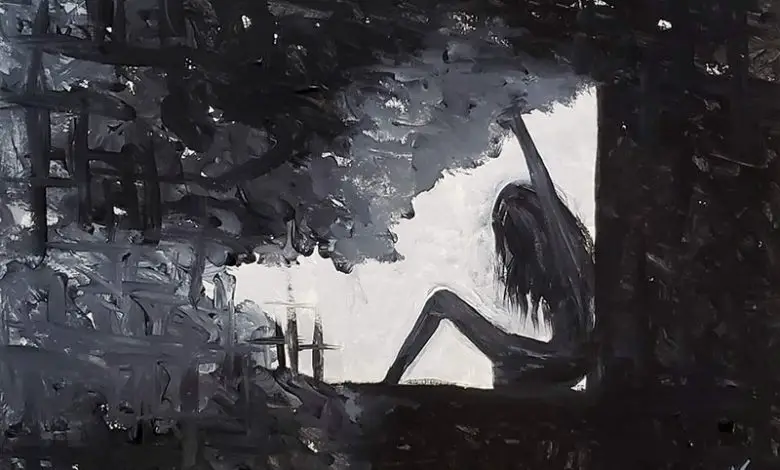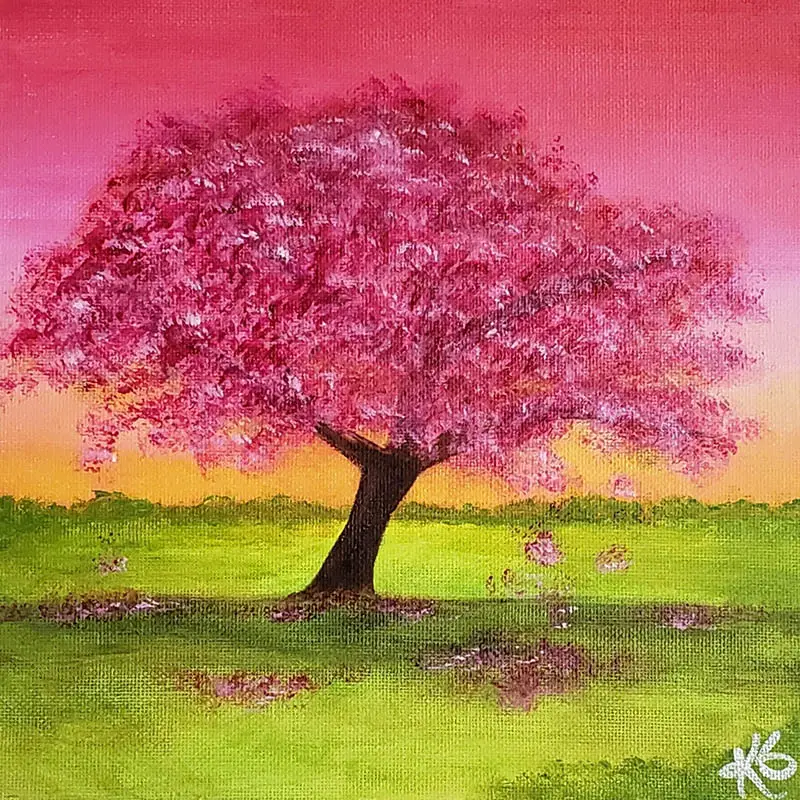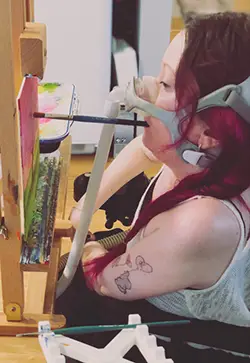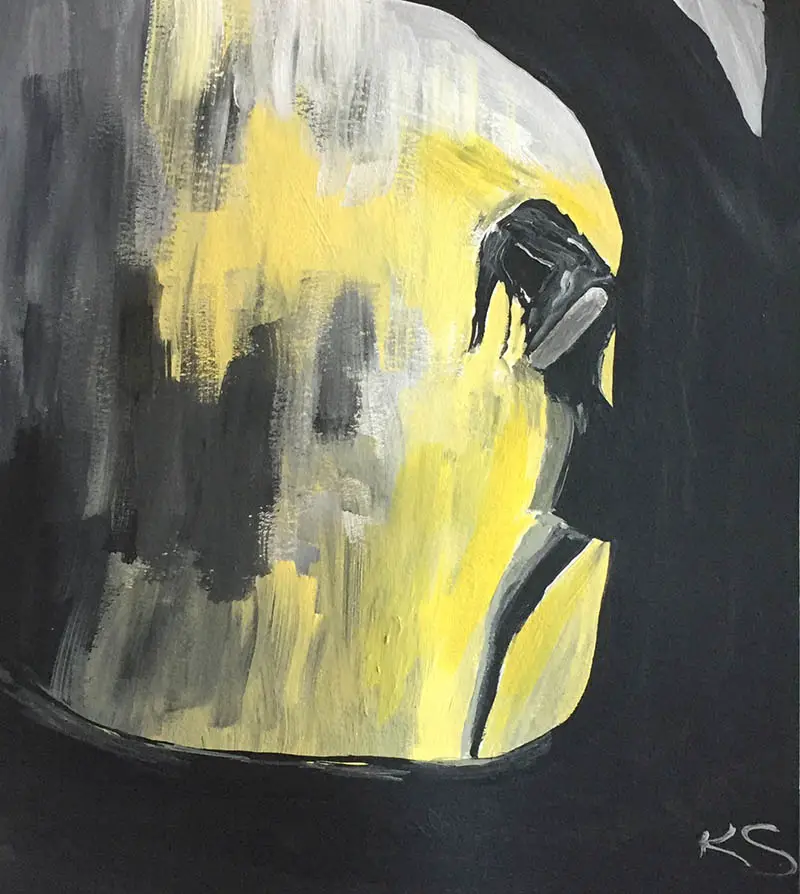
Finding a voice and an outlet through mouth painting
Kaileen Selig has had a life-changing year. She was diagnosed with Charcot-Marie-Tooth type 2 after having experienced its symptoms her entire life. Since, she has discovered mouth painting, an artistic outlet that allows her to express herself and cope with her disability.
 When I tell people I paint, people often look down at my hands bewildered. If you saw my hands, you would agree that they don’t look like they could hold a paintbrush, let alone produce a painting.
When I tell people I paint, people often look down at my hands bewildered. If you saw my hands, you would agree that they don’t look like they could hold a paintbrush, let alone produce a painting.
After a little chuckle to myself, I point out that I paint using my mouth. What exactly does that mean? Well, I hold a paintbrush in my mouth and paint. It’s as simple as that.
My name is Kaileen, I am 27 years old and a mouth painter living in Greater Vancouver, Canada. I have used a power wheelchair since I was eight years old, along with other medical interventions, such as a tube to feed me and non-invasive ventilation.
I grew up without a diagnosis as specialists could not pinpoint an exact condition that correlated with my symptoms. I was consistently told my symptoms were similar to Spinal Muscular Atrophy, yet I tested negative for it. It was strange not knowing what was wrong with me, but being undiagnosed never bothered me.
However, when I was 22 I suddenly lost the majority of my voice. Once again, no one could identify a cause. This unexpected change left me questioning what was going on with my body, so I went to see a neurologist.
After multiple tests and seeing a geneticist, I was finally diagnosed this year with a very rare neuromuscular disability called Charcot-Marie-Tooth type 2. Although I now have a label, on a day-to-day basis, it hasn’t changed my life.
What it has done though is given me some piece of mind. For example, vocal cord paralysis is a symptom of CMT2. I can now continue living my life without the constant speculation of what is happening to me.
My journey towards becoming an artist

I never could have imagined art would play such a substantial role in my life. I discovered it on a quiet afternoon when my boyfriend casually mentioned that there is an association called the Mouth and Foot Painting Artists. The association consists of people who paint using their mouth or feet. For some reason, it sparked something inside of me. I didn’t have any painting background but I decided to give painting with my mouth a try!
I ordered cheap watercolour paint, paper, and paintbrushes from Amazon and was ready to start. Except, I then realised that I didn’t have a way to reach the paper… so I propped up against a Lady Gaga book I had and used it as an easel. I was really ready to start!
Since then I have been teaching myself how to paint with watercolours, $2 acrylics, fancy $20 acrylics and an actual easel! But most importantly, how to paint using only my mouth.
Mouth painting logistics
 Although the idea of mouth painting is as simple as holding a paintbrush in my mouth and painting, there is a lot a mouth painter needs to consider when preparing for painting.
Although the idea of mouth painting is as simple as holding a paintbrush in my mouth and painting, there is a lot a mouth painter needs to consider when preparing for painting.
For instance, you don’t want to put just any type of pencil in your mouth to sketch your ideas. Why? Erasers. Have you ever tasted an eraser? I highly recommend that you don’t. How about pencils that don’t have an eraser on the end? Well, with many pencils you can see the top of the led. Much like erasers, led is not something you want in your mouth.
My solution is to wrap cellotape around the end. But you don’t want to use a tape that will become soggy, or one with a super sticky adhesive because – gross.
Other things I have to consider are the size and weight of the paintbrushes I use. I’m not going to get very far in a painting if my mouth is sore after a few strokes.
I also need to have my palette at a specific height so that I can reach it to mix colours and apply paint to my brush. These are just a few examples of the extra prep it takes to mouth paint compared to painting using your hands.
The inspiration behind my paintings
People tend to ask what inspires me to paint. I’m not sure whether I have an exact answer for that. What I am sure of is that I want my art to evoke a feeling when someone sees it.
Many of my paintings have a dark side to them, which was never the intention. I think that the difficulty of living with a progressive disability tends to express itself through my art. I am typically a positive person, but sometimes life is hard and can straight up suck. But that’s okay in my opinion
Painting has become a way of expressing myself, giving me a voice when my physical one was lost. Mouth painting makes me feel proud of my body’s ability to create art after losing any ability to do so with my hands. Feeling proud of my body is not something I am used to, so I am thankful for feeling this way.

My future as a mouth painter
I am now a Student Member of the Association of Mouth and Foot Painting Artists (MFPA) and Vereinigung der mund- und fussmalenden Künstler (VDMFK). I receive a scholarship from MFPA, which allows me to grow and develop as an artist.
I have just moved into a beautiful studio space at 100 Braid St Studios as my kitchen table isn’t quite cutting it anymore. I have also registered to take some courses at an art school in Vancouver. I’d love to have my own exhibition in the next year and I have some ideas – but no spoilers here!
My life has changed drastically in just over one year. If you had said to me a few years ago that I would be a mouth painter, I would have first asked what that is. Then I would have laughed and not believed you.
Yet, here I am today, writing about my experience thus far with mouth painting. I hear the phrase “you’re so inspirational” at times. While I respect that is how someone feels when they see or hear my story, I very much disagree.
I’m just a 20-something girl living my life and figuring things out as I go. My advice to others in a similar situation is to just keep experimenting. Sometimes things will work and sometimes they won’t, and that’s okay. Whatever you do, don’t let the things you can’t do define who you are.
By Kaileen Selig
More on Disability Horizons…
- Disabled comedian ‘Lost Voice Guy’ wins Britain’s Got Talent 2018
- Be inspired by wheelchair dance as we interview two champions
- Candoco Dance Company: it’s about what you can do not what you can’t
Get in touch by messaging us on Facebook, tweeting us @DHorizons, emailing us at editor@disabilityhorizons.com or leaving your comments below.